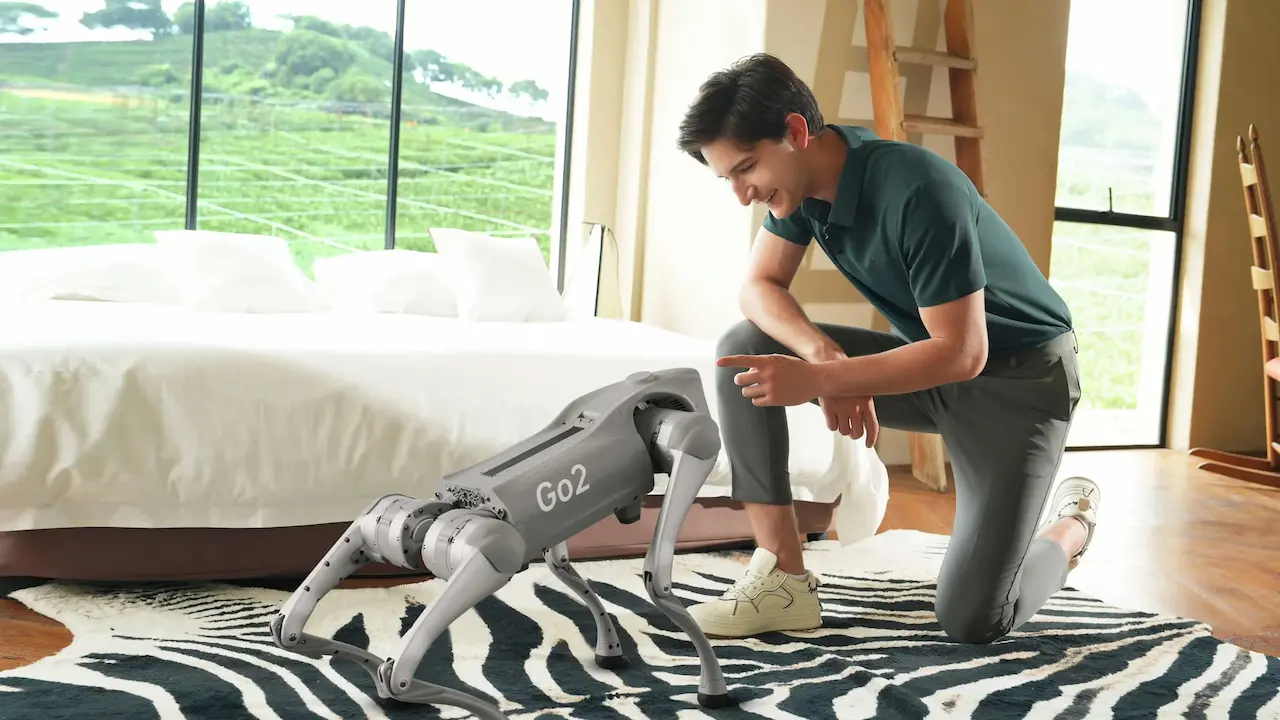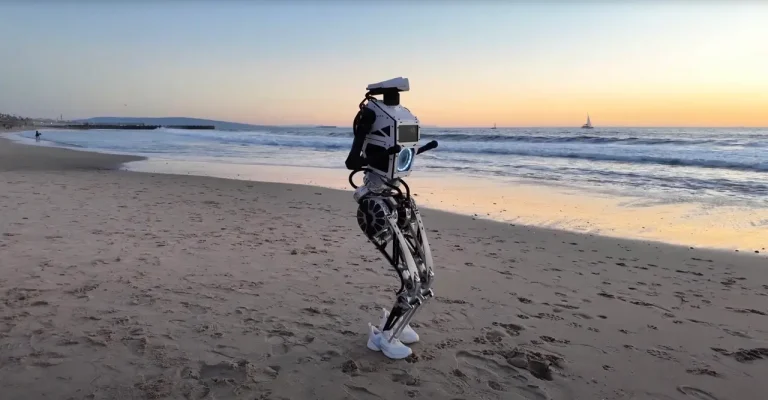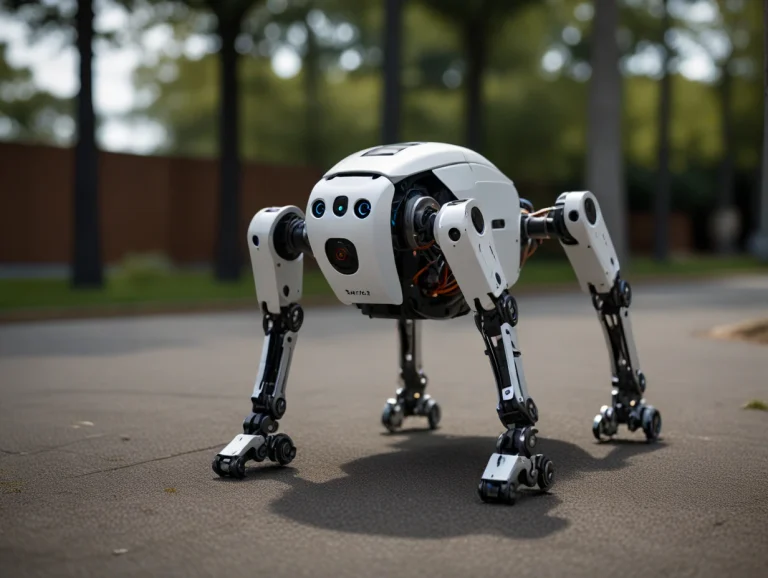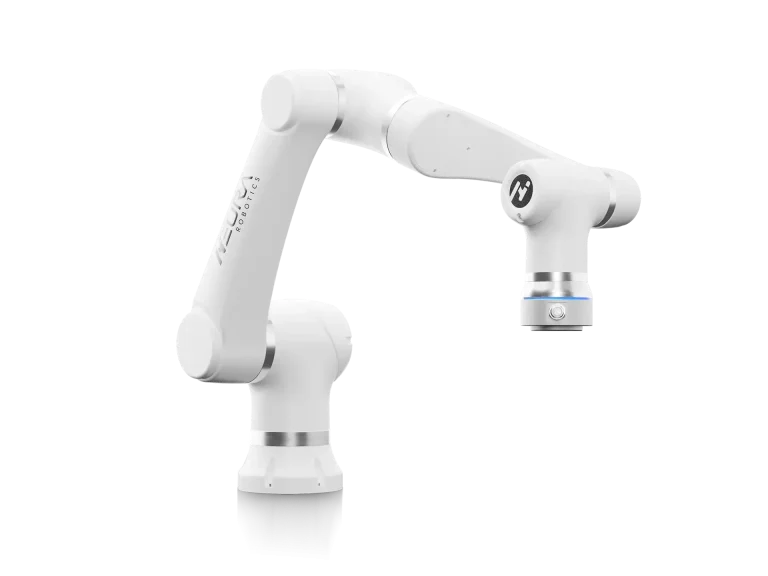In the rapidly evolving field of robotics, the concept of embodied intelligence has emerged as a groundbreaking paradigm, pushing the boundaries of what machines can perceive, learn, and accomplish in the physical world. At the forefront of this revolution stands the Unitree Go2, a remarkable quadruped robot that exemplifies the pinnacle of embodied intelligence. Developed by Unitree Robotics, a Chinese technology company known for its innovative approach to robotics, the Go2 represents a significant leap forward in the quest to create machines that can seamlessly interact with and adapt to their environment.
This blog post delves into the intricacies of the Unitree Go2, exploring its advanced features, capabilities, and potential applications. We’ll examine how this quadruped robot is reshaping our understanding of embodied intelligence and paving the way for a future where robots and humans coexist and collaborate in unprecedented ways.
The Evolution of Quadruped Robotics
To fully appreciate the significance of the Unitree Go2, it’s essential to understand the evolution of quadruped robotics. The concept of legged locomotion in robots has been a subject of fascination for researchers and engineers for decades. Early attempts at creating four-legged robots were often clunky, slow, and limited in their capabilities. However, as technology advanced, so did the sophistication and agility of quadruped robots.
Unitree Robotics, founded in 2016, has been at the forefront of this evolution. The company’s earlier models, such as the Laikago and the A1, laid the groundwork for the development of the Go2. Each iteration brought improvements in stability, power efficiency, and adaptability. The Go2, introduced in 2023, represents the culmination of years of research and development, incorporating cutting-edge technologies and pushing the boundaries of what’s possible in quadruped robotics.
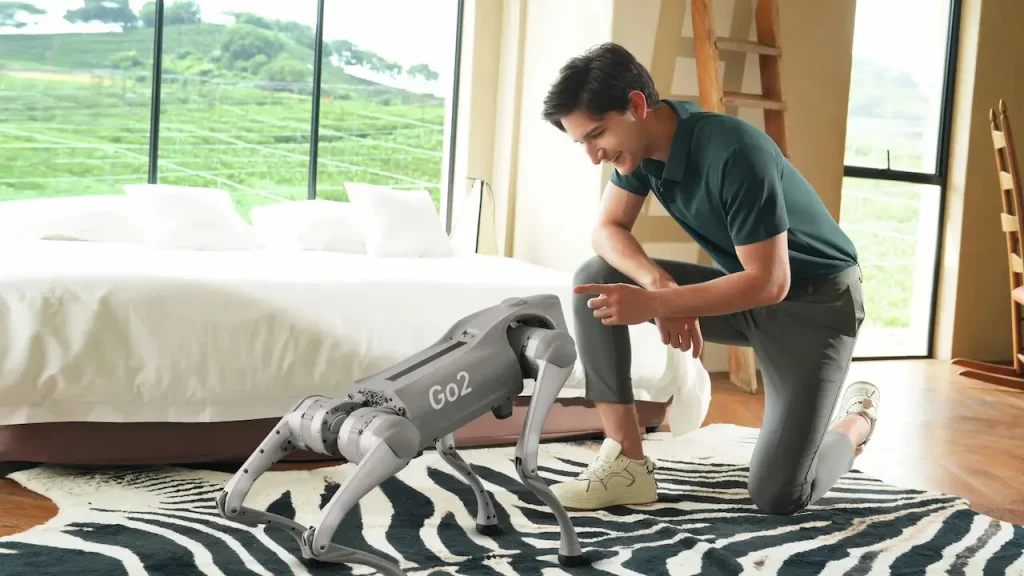
Advanced Perception: The Eyes and Ears of Go2
At the heart of the Unitree Go2’s capabilities lies its advanced perception system. The robot is equipped with a suite of sensors that allow it to perceive and interpret its environment with remarkable accuracy. The centerpiece of this system is the innovative 4D LIDAR L1 sensor, a technology that sets the Go2 apart from its predecessors and competitors.
The 4D LIDAR L1 sensor provides the Go2 with a high-resolution, three-dimensional view of its surroundings. Unlike traditional LIDAR systems, which offer a static snapshot of the environment, the 4D LIDAR adds a temporal dimension, allowing the robot to track moving objects and predict their trajectories in real-time. This capability is crucial for navigating dynamic environments and interacting safely with humans and other moving objects.
Complementing the LIDAR system is an array of cameras, including a wide-angle fish-eye camera for a broad field of view, a stereo camera for depth perception, and an infrared camera for low-light conditions. These visual sensors work in concert with the LIDAR to provide a comprehensive understanding of the robot’s surroundings.
The Go2 also incorporates advanced inertial measurement units (IMUs) and proprioception sensors. These allow the robot to maintain an accurate sense of its own body position and movement, essential for maintaining balance and executing precise movements across various terrains.
Unmatched Agility: Mastering Movement
One of the most striking features of the Unitree Go2 is its exceptional agility. The robot’s design and control systems allow it to navigate a wide range of terrains with ease, from smooth indoor floors to rough outdoor surfaces. This versatility is achieved through a combination of robust hardware and sophisticated software.
The Go2’s legs are powered by high-torque motors that provide the strength and precision needed for dynamic movements. Each leg has three degrees of freedom, allowing for a wide range of motion. The robot’s control system constantly adjusts the position and force of each leg, enabling it to maintain stability even on uneven or shifting surfaces.
What truly sets the Go2 apart is its ability to adapt its gait in real-time. The robot can seamlessly transition between different walking patterns, from a slow, stable walk to a rapid trot or even a dynamic gallop. This adaptability allows the Go2 to optimize its movement for efficiency and stability based on the terrain and the task at hand.
Perhaps most impressively, the Go2 can perform acrobatic maneuvers that were once thought impossible for quadruped robots. It can jump over obstacles, climb stairs, and even execute backflips. These capabilities not only demonstrate the robot’s physical prowess but also showcase the advanced control algorithms that enable such complex movements.
Cognitive Capabilities: The Brain Behind the Brawn
While the Go2’s physical capabilities are impressive, it’s the robot’s cognitive abilities that truly exemplify the concept of embodied intelligence. The Go2 is not merely a sophisticated machine; it’s a learning system capable of adapting to new situations and improving its performance over time.
At the core of the Go2’s intelligence is a powerful onboard computer running advanced artificial intelligence algorithms. These algorithms process the vast amount of sensory data collected by the robot’s perception systems, making sense of the environment and informing the robot’s decision-making processes.
The Go2 employs machine learning techniques to continuously refine its understanding of the world. For example, it can learn to recognize and navigate around new types of obstacles it encounters, improving its performance in unfamiliar environments. This ability to learn and adapt is crucial for real-world applications where robots must operate in unpredictable and changing conditions.
Moreover, the Go2’s AI system enables it to perform complex tasks autonomously. It can map its environment, plan efficient routes, and make decisions about how to accomplish its objectives. This level of autonomy makes the Go2 suitable for a wide range of applications, from industrial inspection to search and rescue operations.
The robot also demonstrates impressive cognitive capabilities in its interaction with humans. It can recognize and respond to voice commands, gestures, and even facial expressions, allowing for intuitive human-robot interaction. This feature opens up possibilities for the Go2 to serve as a robotic assistant in various settings, from homes to workplaces.
Versatility in Application: From Industry to Research
The Unitree Go2’s combination of advanced perception, agility, and intelligence makes it an incredibly versatile platform suitable for a wide range of applications. Here are some of the key areas where the Go2 is making an impact:
- Industrial Inspection: The Go2’s ability to navigate complex environments makes it ideal for inspecting industrial facilities, pipelines, and infrastructure. Its cameras and sensors can detect anomalies and potential issues that might be missed by human inspectors.
- Search and Rescue: In disaster scenarios, the Go2 can navigate through rubble and unstable terrain to locate survivors. Its thermal imaging capabilities allow it to detect heat signatures, while its agility enables it to reach areas inaccessible to human rescuers.
- Agriculture: The Go2 can be used for precision agriculture, monitoring crop health, and even performing tasks like selective harvesting. Its ability to navigate rough terrain makes it suitable for use in various agricultural settings.
- Security and Surveillance: With its advanced perception systems and ability to operate autonomously, the Go2 can serve as a mobile security platform, patrolling areas and alerting human operators to potential security threats.
- Research and Education: The Go2 serves as an excellent platform for robotics research and education. Its open architecture and compatibility with popular robotics frameworks like ROS (Robot Operating System) make it an ideal tool for experimenting with new algorithms and applications.
- Entertainment and Performances: The Go2’s agility and ability to perform acrobatic maneuvers make it suitable for entertainment purposes, such as performances and demonstrations that showcase the capabilities of advanced robotics.
Advanced Features: Pushing the Boundaries
The Unitree Go2 incorporates several advanced features that further enhance its capabilities and versatility:
- ISS 2.0 Intelligent Side-follow System: This feature allows the Go2 to autonomously follow a designated target while maintaining a consistent distance and orientation. This can be particularly useful in scenarios where the robot needs to assist or accompany humans.
- Object Recognition and Manipulation: Equipped with a robotic arm, the Go2 can identify, grasp, and manipulate objects in its environment. This capability opens up possibilities for the robot to perform tasks that require interaction with physical objects.
- Autonomous Navigation and Mapping: The Go2 can create detailed 3D maps of its environment and navigate autonomously, even in GPS-denied environments. This feature is crucial for applications in indoor or underground settings.
- SDK and ROS Compatibility: The Go2 comes with a comprehensive Software Development Kit (SDK) and is compatible with the Robot Operating System (ROS). This allows developers and researchers to create custom applications and integrate the Go2 into existing robotic systems.
- Cloud Connectivity: The robot can connect to cloud platforms, enabling remote monitoring, control, and data analysis. This feature facilitates the integration of the Go2 into Internet of Things (IoT) ecosystems and allows for centralized management of multiple units.
The Impact and Future of Embodied Intelligence
The Unitree Go2 represents a significant milestone in the development of embodied intelligence. By combining advanced perception, agility, and cognitive capabilities in a robust and versatile platform, it demonstrates the potential of robots to operate effectively in complex, real-world environments.
The success of the Go2 has implications that extend far beyond its immediate applications. It serves as a proof of concept for the potential of quadruped robots to assist humans in a wide range of tasks, from dangerous industrial inspections to delicate search and rescue operations. As the technology continues to evolve, we can expect to see even more sophisticated robots that can seamlessly integrate into our daily lives and work alongside humans in various settings.
Moreover, the Go2 is helping to bridge the gap between academic robotics research and practical applications. Its open architecture and versatility make it an ideal platform for testing new algorithms and approaches in real-world conditions. This synergy between research and application is crucial for driving innovation in the field of robotics.
Looking ahead, the development of robots like the Go2 is likely to have profound implications for various industries. We may see the emergence of new business models and services built around the capabilities of advanced quadruped robots. For example, robotics-as-a-service models could make these sophisticated machines accessible to a wider range of businesses and organizations.
The Go2 also raises important questions about the future of human-robot interaction. As robots become more capable and autonomous, it will be crucial to develop frameworks for safe and effective collaboration between humans and machines. The intuitive interaction capabilities of the Go2 provide a glimpse into how this future might unfold.
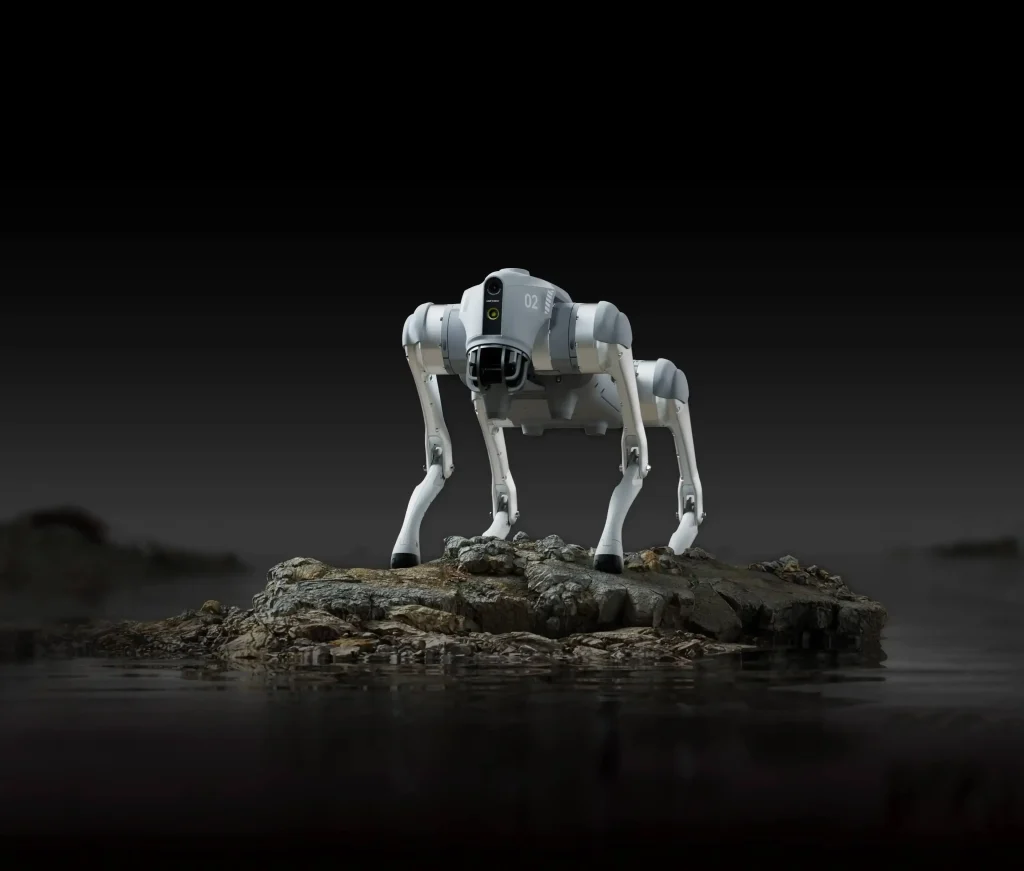
Conclusion
The Unitree Go2 stands as a testament to the rapid progress being made in the field of robotics and embodied intelligence. Its advanced capabilities in perception, movement, and cognition represent a significant step forward in creating machines that can effectively operate in and adapt to the real world.
As we look to the future, the Go2 serves as both an inspiration and a platform for further innovation. It demonstrates the potential of robotics to enhance human capabilities, improve safety in dangerous environments, and open up new possibilities across various industries.
While there are still challenges to overcome, particularly in areas such as energy efficiency and long-term autonomy, the Go2 provides a solid foundation for future developments. As researchers and engineers continue to push the boundaries of what’s possible, we can expect to see even more remarkable advancements in the field of embodied intelligence.
The Unitree Go2 is not just a technological marvel; it’s a harbinger of a future where robots and humans work together seamlessly, enhancing our capabilities and transforming the way we interact with the world around us. As we continue to explore and develop this technology, we stand on the brink of a new era in robotics – one that promises to revolutionize industries, improve lives, and expand the horizons of what’s possible in the realm of intelligent machines.
*The above content comes from the Internet

